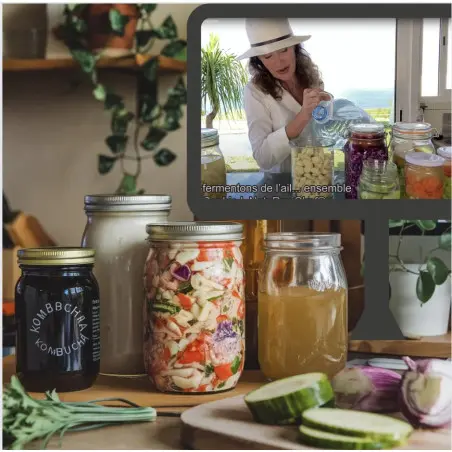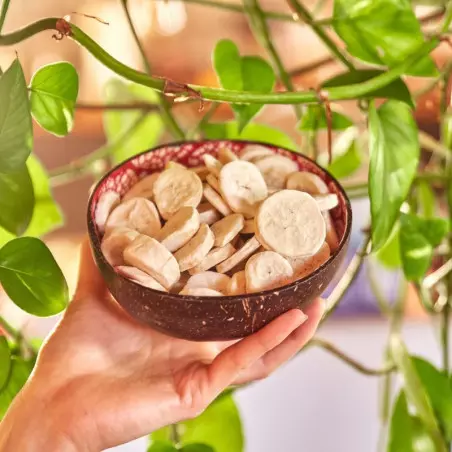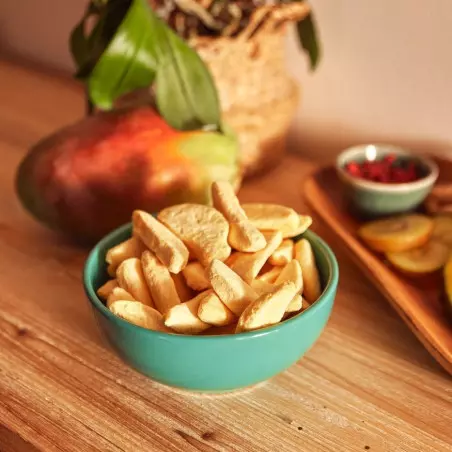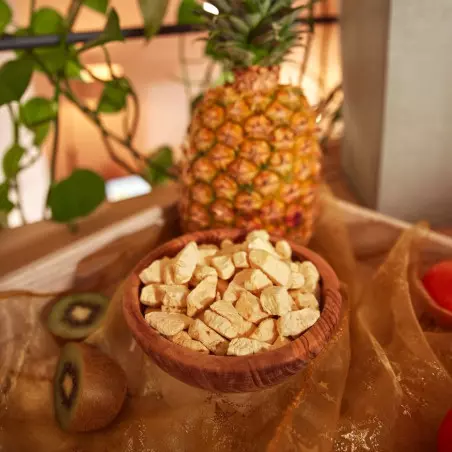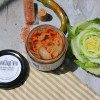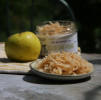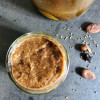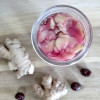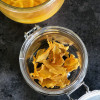Summer is the ideal season to enjoy an abundance of fresh fruits and vegetables. But how can you savor these summer delights all year round? In this article, we will explore various methods of preserving fruits and vegetables, focusing on natural techniques that respect nutrients. Whether you are a fan of raw food or looking to adopt a healthier and more sustainable lifestyle, you will find practical tips and valuable information here.
Here is what you will discover in this article:
- The best natural preservation techniques,
- How to preserve the nutrients in your food,
- Tips for optimizing storage space,
- Methods suitable for different types of fruits and vegetables.
Dehydration: An Effective Ancient Method
Dehydration is one of the oldest food preservation techniques, used for centuries to extend the shelf life of fruits and vegetables. By removing moisture, this method significantly reduces the risk of mold and bacteria while preserving a large portion of the essential nutrients. Due to its simplicity and effectiveness, dehydration is particularly favored by those looking to preserve summer flavors without compromising nutritional quality.
One of the main advantages of dehydration is its ability to concentrate flavors and nutrients while significantly reducing the weight and volume of the food. This not only facilitates storage but also allows you to enjoy nutrient-rich foods even in the middle of winter. Unlike other methods, dehydration requires no additives or preservatives, making it a perfect option for those who prioritize a healthy and environmentally friendly diet.
Which Foods to Dehydrate?
Dehydration is a versatile preservation method that adapts to a variety of fruits and vegetables. It demonstrates that food preservation can effectively maintain their flavor and nutritional value, provided the products best suited to this technique are selected.
Fruits to Dehydrate: Apples, pears, bananas, and strawberries are among the most popular fruits for dehydration. Once dried, these fruits offer a burst of concentrated flavors and are perfect for healthy snacks. Grapes, transformed into raisins, and apricots are also excellent candidates, offering natural sweetness and long shelf life.
Vegetables to Dehydrate: On the vegetable side, tomatoes, peppers, and mushrooms are particularly well-suited to this method. Sun-dried tomatoes, for example, are a Mediterranean delicacy full of flavor. Zucchini and carrots, once dehydrated, are ideal for adding crunch to your salads or soups.
Herbs and Aromatics: Do not overlook aromatic herbs like basil, thyme, and rosemary. Their dehydration allows you to capture and preserve their powerful aromas, ideal for seasoning your dishes throughout the year.
For optimal results, prioritize fruits and vegetables from organic farming to avoid pesticide residues and maximize health benefits. By choosing organic foods, you also support sustainable and environmentally friendly farming practices.
How to Dehydrate at Home?
Home dehydration is an accessible method that allows you to easily preserve your favorite fruits and vegetables. To start, it is essential to choose fresh and ripe products, as the initial quality of the food directly influences the final result. Here are some techniques and equipment to successfully dehydrate at home:
- Using an electric dehydrator: This specialized appliance is designed to remove moisture evenly and in a controlled manner. It is ideal for those who wish to regularly dehydrate large quantities of food. Set the temperature according to the type of fruit or vegetable, generally between 40 and 50 degrees Celsius, and monitor until the foods are sufficiently dry.
- Convection Oven: If you do not have a dehydrator, a convection oven can be an alternative. Arrange the foods in a thin layer on a baking sheet, set the oven to the lowest possible temperature, and leave the door slightly ajar to allow moisture to escape. This method requires increased attention to avoid cooking the foods.
- Solar Method: For an eco-friendly choice, solar dehydration uses the sun's energy. Arrange sliced fruits or vegetables on a tray covered with cloth or fine mesh and expose them directly to the sun, ensuring to turn them regularly. Protect them from insects with a light mosquito net. This technique depends on the climate and level of sunlight.
- Tip for Successful Dehydration: Cut the foods into uniform slices to ensure even dehydration. Fruits like apples, berries, and bananas are particularly well-suited to this process, as are some vegetables such as tomatoes, peppers, and mushrooms.
No matter the method chosen, the key is to ensure that the foods are completely dehydrated before storing them to prevent mold formation. Once dehydrated, store them in airtight containers in a cool, dry place. By mastering this technique, you can enjoy summer flavors all year round while benefiting from a balanced, healthy, and sustainable diet.

Lacto-fermentation: Preserve and Enrich Your Foods
Lacto-fermentation is an ancient preservation method that has stood the test of time due to its numerous health benefits and its ability to enrich foods with nutrients and flavors. This process relies on the action of lactic ferments, bacteria naturally present on foods, which transform sugars into lactic acid. This not only preserves fruits and vegetables but also enhances their nutritional profile by increasing their vitamin content, such as vitamins C and B, while promoting a healthy gut flora.
Ideal Foods for Lacto-fermentation
Lacto-fermentation is a method of preserving vegetables and fruits, offering an explosion of flavors and nutritional benefits for health.
Popular Vegetables for Lacto-fermentation
- Cabbage: Transformed into sauerkraut, it becomes a classic rich in probiotics.
- Radishes and carrots: These cruciferous vegetables gain in flavor and nutritional value thanks to lactic acid.
- Cucumbers: Ideal for making homemade pickles, they bring freshness and crunch.
Fruits Suitable for Lacto-fermentation
- Apples and pears: Fermented, they create unique versions of ciders or compotes.
- Citrus fruits: Although less common, fermented lemons are excellent condiments.
Benefits of Lacto-fermentation
- Complex flavors: This method enriches your dishes with unique aromas and offers a variety of interesting textures.
- Additional nutrients: Enjoy an abundance of natural probiotics and an increased concentration of nutrients.
- Gut health: Strengthen your microbiota by incorporating these fermented foods.
Experiment with different fruits and vegetables to discover your favorite combinations and enrich your daily life with these ancestral gastronomic treasures.
Practical Guide to Lacto-fermentation
Lacto-fermentation is a simple and effective method that allows for extended preservation of your fruits and vegetables while optimizing their nutritional value. Here is a step-by-step guide to successfully fermenting at home and making your foods a source of natural probiotics.
- Food Selection: Choose fresh and organic fruits and vegetables to ensure the best results. Cabbage, carrots, and cucumbers are particularly suitable for lacto-fermentation, as are beets for their nutrient richness.
- Preparation: Carefully wash your produce and cut them into small, uniformly sized pieces. This facilitates the fermentation process and ensures an even distribution of flavors.
- Salting and Seasoning: Add unrefined salt to your vegetables. Salt plays an essential role in fermentation, protecting against undesirable microorganisms and helping to create the ideal environment for the development of lactic bacteria. You can also add herbs like dill, juniper, or garlic to add a touch of flavor and enrich the taste.
- Jar Filling: Place your foods in a clean glass jar, packing them tightly to eliminate air pockets. Then pour salted water to completely cover the vegetables. Ensure that the foods remain submerged to avoid contact with air, which could cause mold.
- Fermentation: Seal the jar tightly and leave it at room temperature, away from direct sunlight. Fermentation generally lasts from a few days to several weeks, depending on the ambient temperature and desired taste. The longer you let it ferment, the more pronounced the taste will be.
- Storage: Once fermentation is complete, store your foods in the refrigerator to slow down the process. Their shelf life can extend over several months while remaining rich in nutrients.
> Feel free to visit our store for our selection of lacto-fermented foods, as well as our various trainings and webinars on the art of lacto-fermentation.
Integrating this process into your dietary routine is an original way to consume living foods while benefiting from their optimal nutritional values. With a bit of experimentation, you'll discover a multitude of new flavors that will delight your taste buds and your gut microbiota.
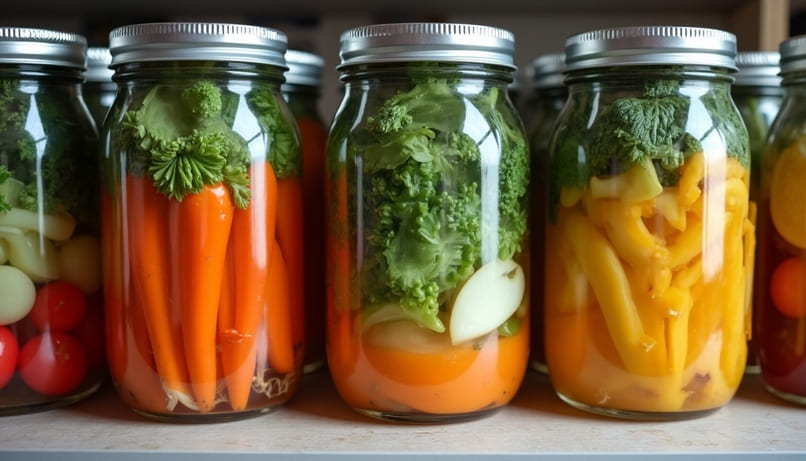
Freezing: A Quick and Practical Solution
Freezing is one of the most popular methods for preserving fruits and vegetables, mainly due to its simplicity and speed. It preserves foods by stopping the development of microorganisms and slowing down the enzymatic processes that degrade nutrients. However, it is important to know the best practices for freezing correctly to maximize the preservation of nutrients and flavors.
Freezing preservation allows you to almost entirely preserve the nutritional value of foods, provided they are frozen quickly after harvest. Using fresh foods helps to best preserve vitamins and minerals, such as vitamin C and potassium. However, the texture can sometimes suffer, especially for fruits and vegetables with high water content. To address this issue, it is essential to select fresh products and prepare them adequately before freezing.
Best Fruits and Vegetables to Freeze
Freezing is a preservation technique suitable for a wide range of fruits and vegetables. Here is a selection of foods that freeze particularly well, preserving their nutrients and flavor to be enjoyed throughout the year.
Fruits to Freeze:
- Berries: Strawberries, raspberries, blueberries, and blackberries are among the small fruits that freeze well. Simply wash, dry, and arrange them in a single layer on a tray before transferring them to freezer bags. Their sweet and tangy taste remains intense even after thawing.
- Banana: Peel and slice bananas before freezing. They are perfect for smoothies or homemade frozen desserts.
- Mango: Peel, pit, and cut into pieces before freezing to keep the tropical flavor intact.
Vegetables to Freeze:
Rich in fiber, these vegetables are ideal for freezing, ready to be added to hot or cold dishes:
- Spinach and Kale
- Broccoli and Cauliflower
- Peas and Green Beans:
Tips for Optimal Freezing
To successfully freeze your fruits and vegetables, a few basic techniques will ensure ideal preservation of flavors and textures:
- Pre-washing: Before freezing them, carefully wash your fruits and vegetables. Then dry them with paper towels and place them in a freezer bag. You can also slice or cut them into pieces according to your preferences.
- Use of suitable containers: Make sure to use airtight freezer bags or cold-resistant glass containers. This prevents the formation of ice crystals that can alter the texture of the food. Label the containers with the freezing date to track the storage duration.
- Quick freezing: Place the food separately on a tray to freeze them quickly before grouping them. This prevents the pieces from sticking together and makes later use easier.
- Labeling: Note the freezing date on each package to track the storage duration. This tracking allows you to respect the preservation time, knowing that most fruits and vegetables maintain their optimal qualities for about 8 to 12 months.
By following these tips, you can extend the enjoyment of your summer fruits and vegetables throughout the year and reduce food waste by avoiding discarding products that ripen too quickly. Adopt this simple and practical method to enrich your meals with natural and nutritious ingredients.
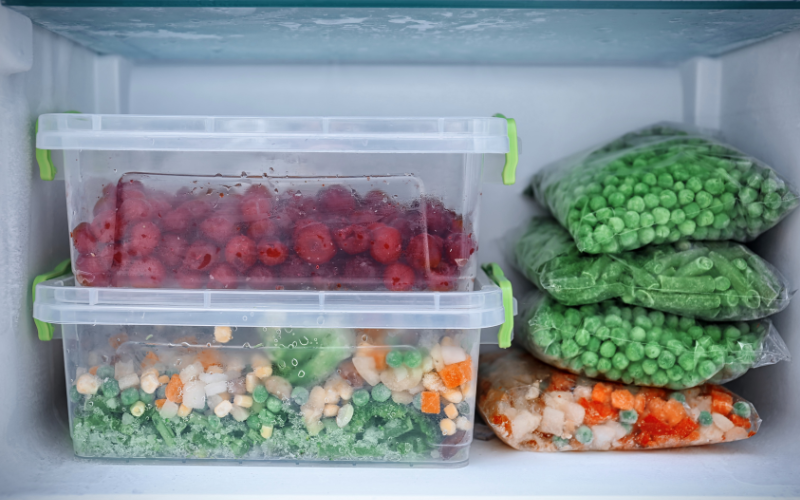
Freeze-drying: preserving the essence of food
Freeze-drying is an innovative preservation technique that involves removing water from food through sublimation, meaning directly transitioning from a solid state to a gaseous state without passing through a liquid state. This process occurs under vacuum, which helps preserve the cellular structure and almost all the nutrients of fruits and vegetables. As a result, freeze-dried products retain their nutritional value, original taste, and aromas, while offering exceptional shelf life.
This method is particularly appreciated for its ability to maintain enzymes and heat-sensitive vitamins, which are often destroyed during traditional preservation methods like pasteurization. In addition to ensuring excellent nutrient preservation, freeze-drying has the advantage of producing light and compact foods, ideal for practical and quick use in many raw recipes. Thus, it allows for the storage of quality food in anticipation of the next season, offering an ideal solution to enjoy nutritious products throughout the year. This technique is a major asset for those seeking both nutritional quality and product longevity.
Fruits and Vegetables Suitable for Freeze-Drying
Freeze-drying is a preferred method for extending the shelf life of fruits and vegetables while preserving their nutritional and organoleptic qualities. Thanks to this process, foods retain their cellular structure, ensuring optimal maintenance of vitamins and minerals. Here are some examples of foods that are particularly well-suited to this technique:
Fruits:
- Strawberries and Raspberries: These red fruits are popular for freeze-drying due to their intense flavor and crunchy texture once dried. They are perfect for enhancing cereals, yogurts, and smoothies, offering a touch of freshness and nutrition even out of season.
- Apples and Bananas: These fruits, already appreciated for their sweet taste, become even more delicious after freeze-drying. Their crunchy slices are ideal for healthy snacks or as ingredients in dried fruit mixes.
- Mangoes, Durian, Jackfruit, and Pineapple: For an exotic experience, freeze-dried tropical fruits bring a sweet and tangy taste, perfect for lovers of natural sweets.
Vegetables:
- Peas: Naturally sweet, freeze-dried peas are an excellent addition to soups or salads to add crunch and color.
- Carrots: Available year-round, freeze-drying carrots preserves their sweet and earthy flavor, making them ideal for enriching dishes or being consumed as snacks.
Freeze-drying is not just a preservation method; it is also an ingenious way to discover new textures and flavors while ensuring the preservation of essential nutrients, making it a preferred choice for those who follow a raw and healthy diet. This technique allows for the desired preservation by extending the shelf life of foods while maintaining their nutritional qualities. To explore more options and integrate these products into your daily life, discover our range of freeze-dried fruits available in our store.
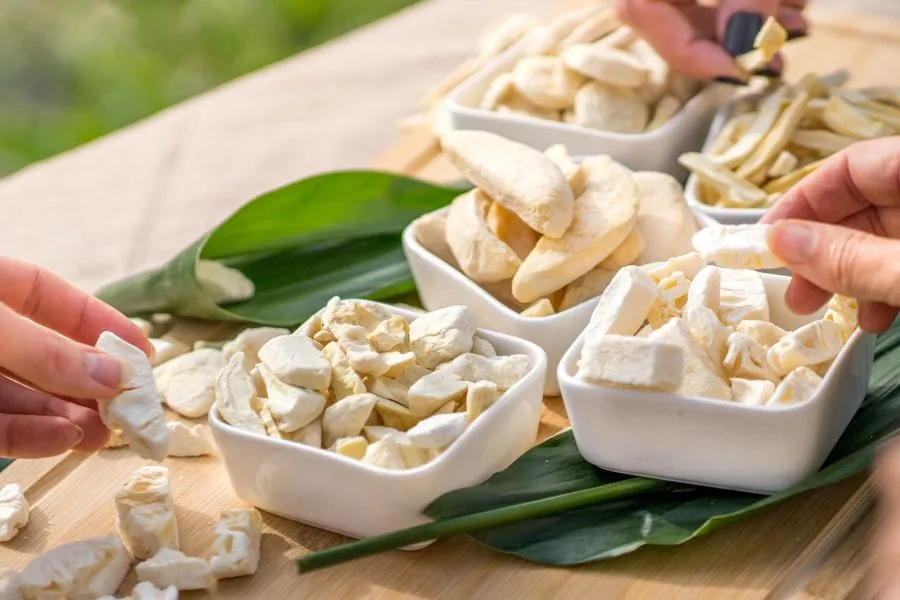
Pascalization: A Cutting-Edge Technology
Pascalization, also known as high-pressure processing, is an innovative preservation method that uses high hydrostatic pressure to inactivate microorganisms and enzymes responsible for food spoilage. This process preserves the quality and nutritional integrity of fruits and vegetables without the need for heat. As a result, pascalized foods retain their original taste, texture, and nutrients, while extending their shelf life.
This process is particularly beneficial for heat-sensitive foods, as it allows delicate components like vitamins and antioxidants to remain intact. Pascalized products are not only safe to consume but also closer to their natural state, ideal for those who prioritize a living diet rich in nutrients. Although this method is mainly used on an industrial scale, it ensures good food preservation, allowing fresh and natural product enthusiasts to enjoy their benefits longer without compromising their quality.
Where to find pascalized products?
Pascalized products represent a technological advancement in the field of food preservation. Although they are primarily available on an industrial scale, they are beginning to appear in some specialty stores and fine grocery stores.
Advantages of pascalized products
These foods are distinguished by:
- Their superior quality
- Their ability to retain original nutrients, flavors, and texture
- The absence of chemical preservatives
Where to find them?
For quality-conscious consumers eager to experience cutting-edge techniques for healthy eating, pascalized products can generally be found:
- In stores focused on living and organic food
- Labeled with mentions regarding high-pressure processing to ensure transparency
Some local producers or startups focused on food innovation also offer these products through online platforms.
Benefits of integrating pascalized products
By integrating pascalized foods into your diet, you benefit from:
- Optimal nutrient preservation,
- Support for a sustainable and innovative approach to food production
The rise of this technology opens new perspectives for food preservation, allowing enjoyment of perishable products while respecting their freshness and nutritional integrity.

Conclusion
By exploring various methods of preserving fruits and vegetables, we have discovered techniques ranging from dehydration to pascalization, each offering unique advantages for preserving the nutritional value and flavor of your favorite foods. With a preservation choice suited to your needs, you can extend the freshness of your products and enjoy them throughout the year.
We encourage you to experiment with these methods and integrate them into your culinary routine. Not only will you extend the lifespan of your harvests, but you will also enrich your diet with tasty and healthy products, in line with your environmental respect values and personal well-being. To continue exploring the fascinating world of living foods and preservation practices, subscribe to our newsletter and regularly receive tips and tricks for a healthy and sustainable diet.
Your Questions and Our Answers (FAQ)
What is dehydration and why is it ideal for preserving fruits and vegetables?
Dehydration is a process that removes moisture from food, thereby reducing the risk of mold and bacteria. It is ideal for preserving fruits and vegetables because it retains a large portion of the nutrients and concentrates the flavors, while also making storage easier by reducing the weight and volume of the food.
Which fruits and vegetables are best suited for dehydration?
Apples, pears, bananas, strawberries, tomatoes, peppers, and mushrooms are perfect for dehydration. These foods retain their flavor and nutritional value well after drying, offering an excellent option for healthy snacks or culinary additions.
How to successfully lacto-ferment vegetables at home?
To lacto-ferment vegetables, start by choosing fresh and organic vegetables. Wash them, cut them into equal pieces, add salt and spices for taste, and place them in a glass jar. Cover them with salted water, seal tightly, and let ferment at room temperature. This method enriches the food with probiotics, beneficial for gut health.
Which fruits and vegetables are most suitable for freezing?
Red fruits like strawberries and raspberries, as well as vegetables like spinach, broccoli, and cauliflower, are well-suited for freezing. Be sure to blanch the vegetables before freezing to preserve their texture and nutrients.
Is freeze-drying a good method for preserving the nutrients in food?
Yes, freeze-drying is excellent for preserving nutrients. This process removes water through vacuum sublimation, maintaining the cellular structure and vitamins of foods, such as strawberries and raspberries, while extending their shelf life.
How is pascalization different from other preservation techniques?
Pascalization uses high hydrostatic pressure to inactivate microorganisms without heat, thus preserving the taste, texture, and nutrients of the food. Although not feasible at home, this industrial method is an alternative to pasteurization, offering fresh and natural products.
Pasteurization, which uses heat to eliminate microorganisms, can degrade heat-sensitive vitamins, thus altering the nutritional value of food. While effective for food safety, it is less advantageous for those seeking optimal nutrient preservation.




